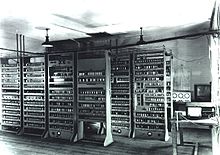
Back EDSAC Byelorussian EDSAC Bulgarian EDSAC Catalan EDSAC Czech EDSAC Danish Electronic Delay Storage Automatic Calculator German EDSAC Spanish EDSAC Estonian EDSAC Basque EDSAC Finnish
 EDSAC I in June 1948 | |
| Developer | Maurice Wilkes and his team at the University of Cambridge Mathematical Laboratory |
|---|---|
| Manufacturer | University of Cambridge |
| Generation | 1 |
| Release date | 6 May 1949 |
| Lifespan | 1949–1958 |
| Discontinued | yes |
| Units shipped | 1 |
| Operating system | None |
| CPU | Derated thermionic valves |
| Memory | 512 17-bit words, upgraded in 1952 to 1024 17-bit words (temperature-stabilized mercury delay lines) |
| Display | Teleprinter |
| Input | five-hole punched tape |
| Power | 11 kW |
| Backward compatibility | None |
| Successor | EDSAC 2 and LEO I |
| Related | EDVAC |
The Electronic Delay Storage Automatic Calculator (EDSAC) was an early British computer.[1] Inspired by John von Neumann's seminal First Draft of a Report on the EDVAC, the machine was constructed by Maurice Wilkes and his team at the University of Cambridge Mathematical Laboratory in England. EDSAC was the second electronic digital stored-program computer, after the Manchester Mark 1, to go into regular service.[2]
Later the project was supported by J. Lyons & Co. Ltd., intending to develop a commercially applied computer and resulting in Lyons' development of the LEO I, based on the EDSAC design. Work on EDSAC started during 1947,[3] and it ran its first programs on 6 May 1949, when it calculated a table of square numbers[4] and a list of prime numbers.[5][6] EDSAC was finally shut down on 11 July 1958, having been superseded by EDSAC 2, which remained in use until 1965.[7]
- ^ Wilkes, W. V.; Renwick, W. (1950). "The EDSAC (Electronic delay storage automatic calculator)". Math. Comp. 4 (30): 61–65. doi:10.1090/s0025-5718-1950-0037589-7.
- ^ The 1948 Manchester Baby computer predated EDSAC as a stored-program computer, but was built largely as a test bed for the Williams tube and not as a machine for general use. See "A brief informal history of the Computer Laboratory". However, the Baby was developed into a practically useful successor, the Manchester Mark 1 of 1949, which was available for general use by other university departments and Ferranti in April 1949, despite still being under development; EDSAC first ran in May 1949, while also still being under development. "50th Anniversary of the Manchester Baby computer". Archived from the original on 9 February 2014. Retrieved 5 January 2014.
- ^ Wilkes, M. V. (1997). "Arithmetic on the EDSAC". IEEE Annals of the History of Computing. 19 (1): 13–15. doi:10.1109/85.560726.
- ^ "Pioneer computer to be rebuilt". Cam. 62: 5. 2011. To be precise, EDSAC's first program printed a list of the squares of the integers from 0 to 99 inclusive.
- ^ Jones, Cliff B.; Lloyd, John L. (24 January 2012). Dependable and Historic Computing: Essays Dedicated to Brian Randell on the Occasion of his 75th Birthday. Springer. p. 29. ISBN 9783642245411.
- ^ "9. The EDSAC, Cambridge University, England". Digital Computer Newsletter. 2 (1). Other early computational problems run on EDSAC; some specifications of the computer: 3. 1 January 1950. Archived from the original on 11 March 2021.
{{cite journal}}: CS1 maint: others (link) - ^ EDSAC 99: 15–16 April 1999 (PDF), University of Cambridge Computer Laboratory, 6 May 1999, pp. 68, 69, retrieved 29 June 2013.